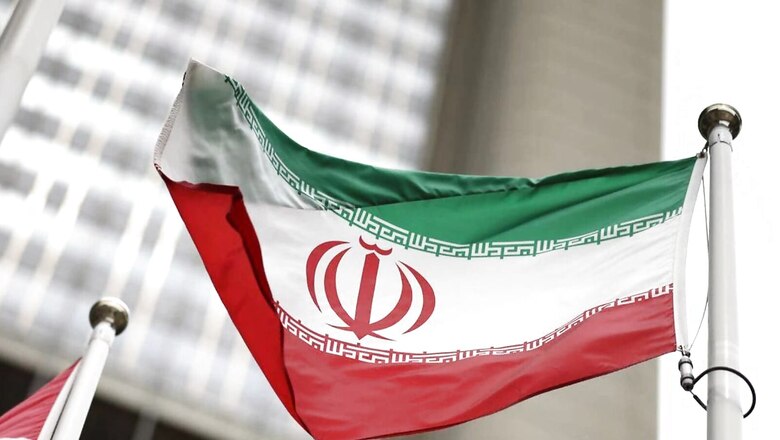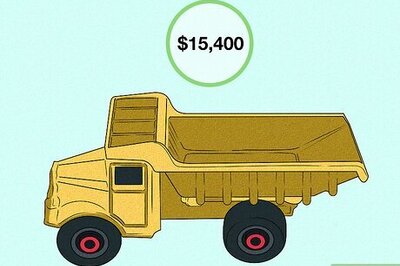
views
A proposal to revive the nuclear agreement between P5+1 and Iran seems imminent and includes the release of billions of dollars in frozen Iranian funds and oil exports in return for the scaling back of its nuclear programme.
As per reports, the deal is likely to be carried out in four phases over two 60-day periods. Iran recently voiced optimism about an agreement on a renewed version of the 2015 nuclear deal with the United States and other foreign powers, formally called the Joint Comprehensive Plan of Action (JCPOA).
Incidentally, Iran’s nuclear programme started post President Eisenhower’s ‘Atoms for Peace’ announcement in 1953 when the US decided to help certain countries which included India, Pakistan, Iran and Israel to develop peaceful civil nuclear energy. The first 5mw nuclear reactor was then set up in 1967 in Tehran University and the US also provided them with uranium.
However, post the 1979 revolution and the subsequent US hostage crisis where members of the US embassy in Tehran were held hostage for over a year, relations plummeted. In 2002 the Mujahedin-e-Khalq (MEK) exposed Iran’s nuclear programme of not “being entirely civilian”. New facilities had come up in Natanz and Arak and the Pakistani nuclear scientist AQ Khan had been involved in giving the designs for centrifuges. In December 2006 sanctions were imposed following the United Nations Security Council Resolution 1737 after Iran refused to comply with United Nations Security Council Resolution 1696, which demanded that Iran halt its uranium enrichment programme. Over the years, sanctions took a serious toll on Iran’s economy.
The JCPOA was signed between Iran and P5+1 following twenty months of intense negotiations on 14 July 2015 in Vienna. Iran agreed to open up its facilities for international inspection and dismantle some of its nuclear programmes. President Donald Trump withdrew from this agreement in May 2018.
Apparently, the revised JCPOA proposal stipulates sanctions on seventeen Iranian banks as well as many economic institutions be lifted after the agreement is signed, as well as release of $7 billion of Iran’s funds which are currently frozen. It also states Tehran will immediately begin to reverse the steps it took to advance its nuclear technology, which is now beyond the scope of what the United Nations nuclear watchdog, the International Atomic Energy Agency, and the 2015 deal’s original signatories say is acceptable.
With a revived nuclear deal, the US and other signatories, France, the United Kingdom, Germany, China and Russia, P5+1, aim to contain Iran’s nuclear programme and prevent what many warn could be a nuclear weapons crisis in the Middle East.
One of the main sticking points to reviving a deal appears to be a safeguard inquiry into Iran’s nuclear programme by the IAEA, which Tehran wants closed before the JCPOA is restored. The nuclear watchdog has demanded more cooperation on traces of man-made nuclear particles found at several Iranian sites years ago, saying that is the only way the inquiry could be terminated.
Another factor is the US designation of Iran’s elite military force, the Islamic Revolutionary Guard Corps (IRGC), as a “foreign terrorist organisation”. The US appears reluctant to meet Tehran’s demand to remove the IRGC from the blacklist to seal the deal.
US Secretary of State Antony Blinken has suggested the IRGC’s “terror” designation falls outside the purview of the nuclear deal and, therefore, requires separate concessions from Iran.
A major sticking point in Iran is that the EU and Biden administration cannot block a future US government from withdrawing from the deal again like Donald Trump. Iran is now focused on obtaining last-minute technical and political concessions from the US that would act as an insurance policy to raise the costs to the US if it withdrew from the deal. The US will have to pay a fine in the event it withdraws from the nuclear agreement again, as it did under the administration of former President Trump in 2018, according to some sources.
“Iran wants a sustainable JCPOA, and that’s why it is insisting on a credible guarantee that the US will not break the promise again,” said Seyed Hossein Mousavian, who previously served as foreign policy adviser to the secretary of the Supreme National Security Council. He said, “Iran needs to be sure about all economic benefits if the JCPOA is revived.”
Ellie Geranmayeh, senior policy fellow and deputy head of the Middle East and North Africa programme at the European Council on Foreign Relations, said: “The two sides are closer than ever in closing the gaps that remain.” She added, “But they need to do so very quickly to utilize the current diplomatic momentum that favours the revival of the nuclear deal.” The fact is that towards the end of any negotiations the most difficult points remain to be resolved.
While the two historic foes have been at geopolitical odds since the 1979 Islamic Revolution that displaced the Shah, their feud has turned deadly in the form of an ongoing series of rocket attacks by “Axis of Resistance” militias against US personnel in Iraq and Syria and, perhaps most notably, the US killing of Iran’s Quds Force Commander Major General Qassem Soleimani by a precision drone strike in Baghdad in January 2020.
President Trump had ordered Soleimani’s killing saying he was planning an “imminent” attack on American personnel in the Iraqi capital. Iran responded to his assassination by firing missiles a few days later at Iraqi bases housing US troops, causing injuries. The attacks and retaliatory strikes heightened tensions in an already volatile region.
Though President Biden was Vice President to President Barack Obama when the 2015 deal was reached, and has said that Trump’s withdrawal in 2018 was a “gigantic mistake”, he has maintained sanctions against Iran, and even added additional ones in the absence of a negotiated US return to the agreement. The US exit also resulted in many countries cutting off trade with Iran on fear of economic punishments from the US.
Iran feels if the US Congress and the Biden administration continue to impose sanctions on Tehran under the guise of missiles, drones, terrorism and human rights issues, it would render the JCPOA practically dysfunctional and undermine the full economic benefits. In other words, Iran feels what sanctions are labelled under doesn’t matter but their effect matters.
In response to being deprived of economic benefits promised in exchange for curbing its nuclear programme, Iran has gradually ramped up nuclear activities, even as Iranian officials repeatedly denied they intended to produce a weapon of mass destruction. However, the uranium enrichment levels were supposed to be at 3.67 percent limit set by the 2015 deal are now at 60 percent, enrichment of 90 percent is needed to build a nuclear bomb. There has also been research by Iran on improved centrifuges.
From the US perspective, the benefits to returning to compliance are the resumption of verifiable limits in Iran’s nuclear programme that would block pathways to building nuclear weapons. If the JCPOA is revised, the accumulation of enriched uranium in Iran would be reversed, and it wouldn’t be allowed to have enough material for a single weapon until 2031.
Among the most critical aspects of the JCPOA was the “verification/information regime which allowed international monitors unprecedented access to Iranian facilities. This served to alert the International Atomic Energy Organisation (IAEA) if Iran attempted to cheat on the limits of the deal.
According to Rose Gottemoeller, a former NATO Deputy Secretary General and US Under Secretary of State for Arms Control and International Security, the benefits of the JCPOA for the US would be that “Iran will be moved farther away from acquiring enough fissile material to make a nuclear bomb — from the current few weeks to at least a few months”.
Israel, America’s closest ally in the region, feels that Iran’s nuclear programme poses security risks for every country in the region. It also fears that the increase in Iran’s income post lifting of sanctions will result in greater funding for both Hamas and Hezbollah. Israeli Prime Minister Yair Lapid has spoken to German Chancellor Olaf Scholz, pressing Israel’s position that efforts to revive a nuclear deal with Iran should end. Israel feels it has the right to act and won’t allow Iran to ‘write them off’.
Iran has also stated that there are ‘foreign players’ who are opposed to the deal and are placing impediments in the negotiations. Both sides also have political issues to confront. Right-wing US politicians and Israel, the arch-rival of Iran, have warned Washington against lifting sanctions on the IRGC.
Micheal McCaul, a Republican in the house Foreign Affairs Committee, has been quoted in the Washington Post as saying: “Attacks by Iranian proxies against US service members in Syria show why we cannot cut a bad nuclear deal with Iran.”
Iran also has those opposed to the deal who saw their views vindicated when the US withdrew from the deal in 2018, while Iran was in full compliance. And they are understandably wary of trusting the promises of another US administration.
According to Bijan Khajehpour, a veteran analyst of the Iranian economy, the country’s exports of crude oil could reach nearly 3 million barrels a day —boosting government revenues by $65 billion annually at current prices.
Ordinary Iranians would see an immediate impact from this in terms of a stronger national currency and reduced inflation, while the country would be able to replenish its National Development Fund and improve its aging infrastructure.
Such sanctions relief would also facilitate more regional trade and investment, meeting the current Iranian administration’s goal of focusing on the neighbourhood. However, for investors willing to invest in Iran there needs to be long term guarantees and protection.
While India supports the JCPOA, an important benefit, particularly for India, is that Iran’s oil will flow again, relieving tight energy markets constricted after Russia’s invasion of Ukraine. There will definitely be a cooling down in the prices of crude. India was one of the major importers of Iranian crude after China and this trade will start again.
Another major benefit for India is the Charbhar project. Removal of sanctions will ease investments as well boost the International North-South Transit Corridor (INSTC), which runs through Iran, and will improve connectivity with five Central Asian Republics.
For Iran there is a deficit of faith in the US system since the Trump administration literally tore up the previous deal. At the same time, it is using its nuclear programme as a leverage to be assimilated in the world order. However, despite the continued bad blood between both countries they also recognise the benefits of the deal if it meets their national interest. While both sides remain committed to salvaging the deal the US also remains committed to ensuring that ‘Iran does not become a nuclear power’.
There is no doubt that the revival of the JCPOA marks a glimmer of optimism in a world faced with increasing accumulating strategic adversities. The deal has the power to defuse an important sticking point and usher in greater stability in a strategically important region. It is clearly in the best interests of all sides to resume the JCPOA, and not allow other political considerations to stand in the way.
The author is an Army veteran. Views expressed are personal.
Read all the Latest Opinion News and Breaking News here




















Comments
0 comment